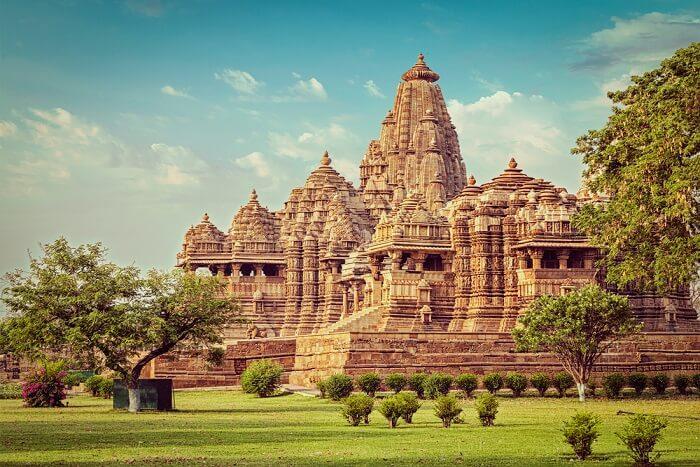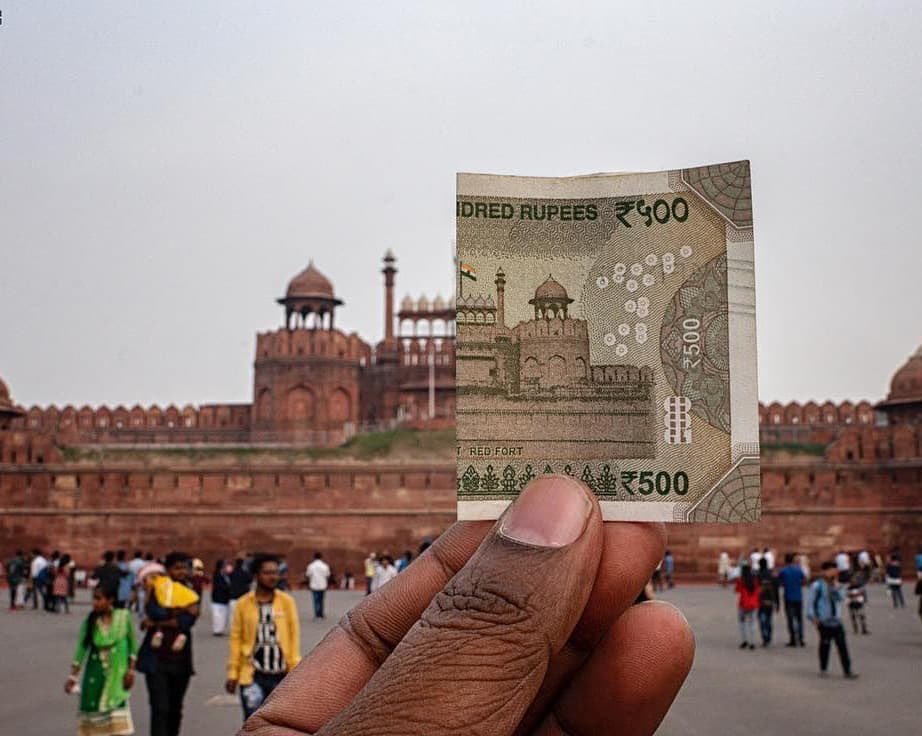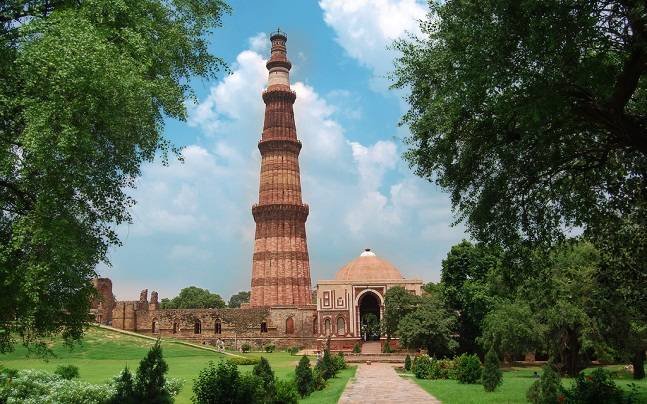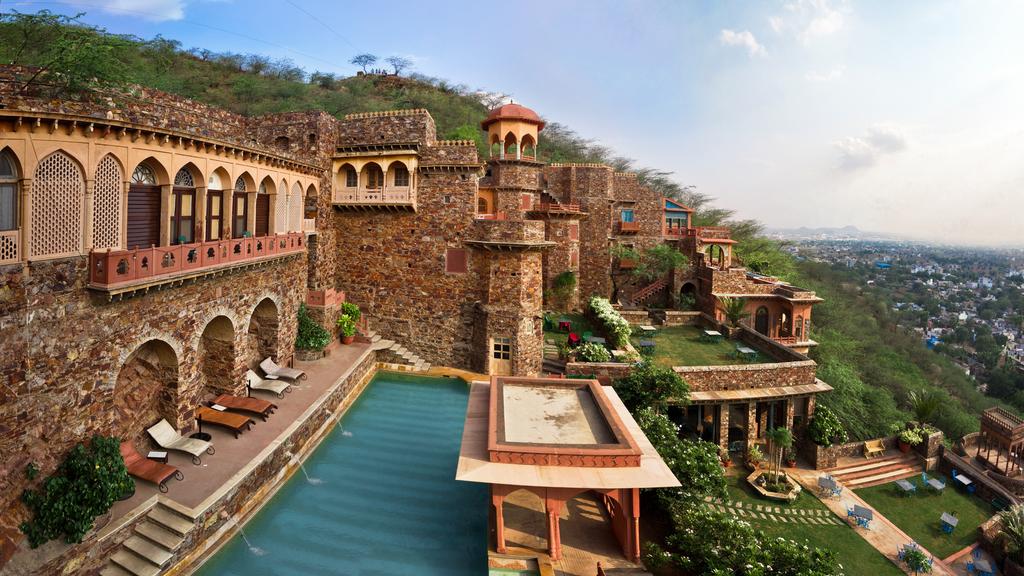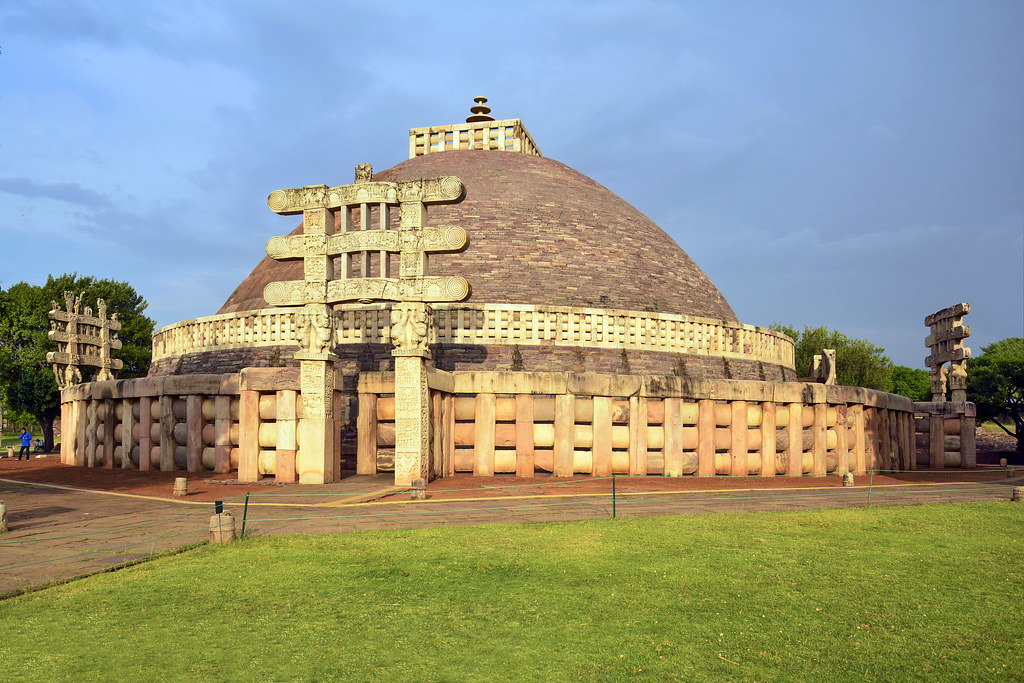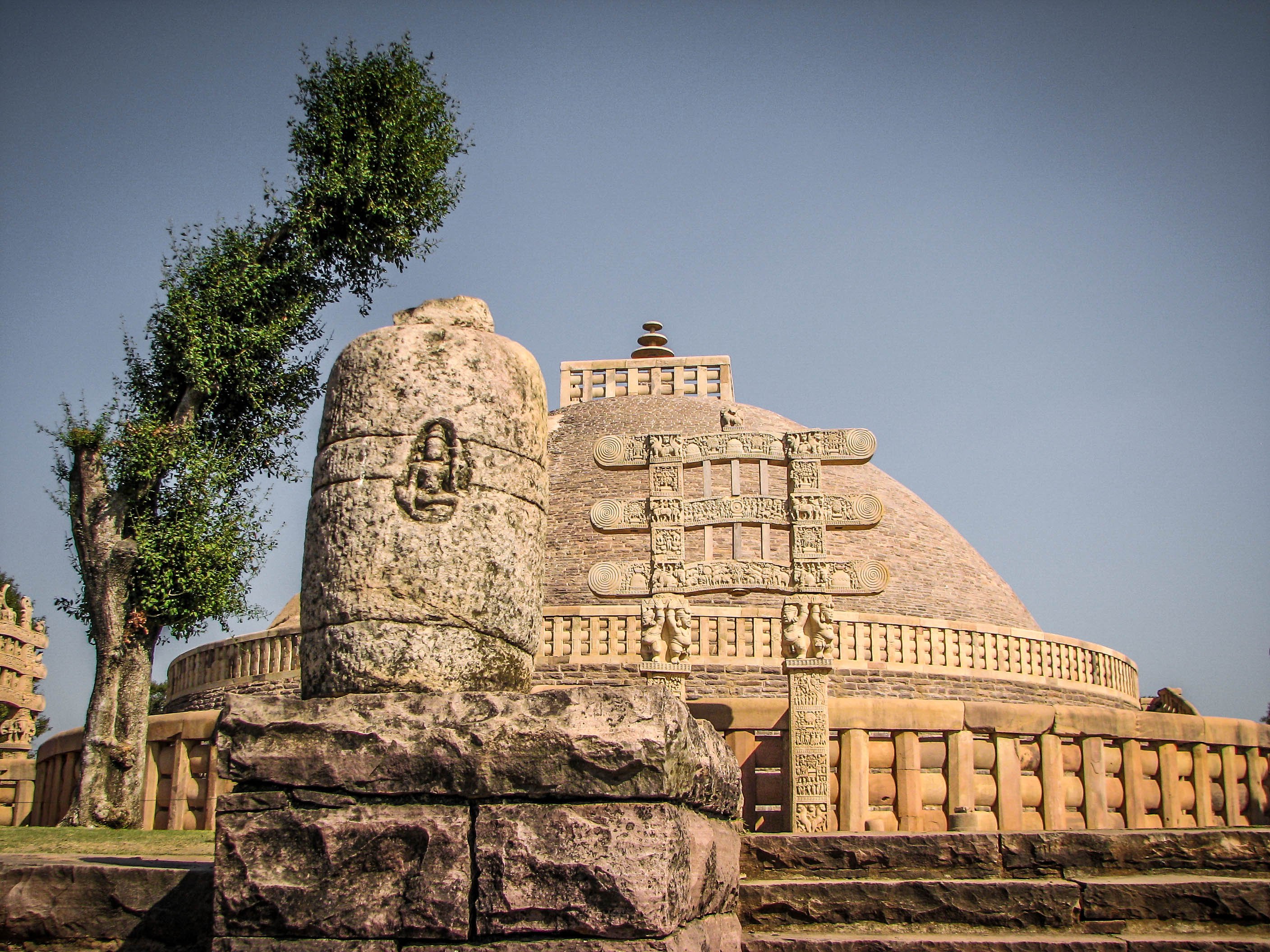
The famous Sanchi Stupa, situated in Madhya Pradesh in India, is a memorial that is built in the city called Sanchi. It is situated at around 46 kilometres, or 26 miles towards the north-east of Bhopal, which is the capital of Madhya Pradesh. It is a Buddhist Complex and is situated on a hilltop. It is located in the Risen District of Madhya Pradesh.
History of Sanchi Stupa
The Sanchi Stupa in Sanchi at Bhopal is one of the most ancient stone structures in India. It is a very significant part of the Indian Architecture. The building of this monument was ordered by the great Indian emperor Ashoka, as early as in the 3rd century BC. The centre of this structure is a Dome-shaped structure made of brick and was built over the vestiges of Buddha.
The structure is also crowned by a parasol like structure, called a ‘Chatra’, which is a symbol of high rank. The aim of this structure was to shelter as well as honour the relics there. Ashoka himself had overseen the construction of this site. Sanchi was the home town of his wife, whose name was Devi. Sanchi was also the place where she and Ashoka had gotten married.
In the first century BC, a few things were added to this construction, those were a balustrade that was encircling the whole structure and also four toranas, which are actually large ornamental gateways. The stupa, built in the Mauryan Period, was made of bricks and it was flourished by the time 11th century came around.
Sanchi is also the centre with numerous stupas around them, one of them being the Satdhara Stupa which lies at a distance of 17 kilometres from Sanchi. The Relics of Sariputra and Mahamoggallana which is enshrined in a Vihara is also close to this place, the Morel Khurd is another one of the closely located stupas.
Sanchi Stupa Architecture
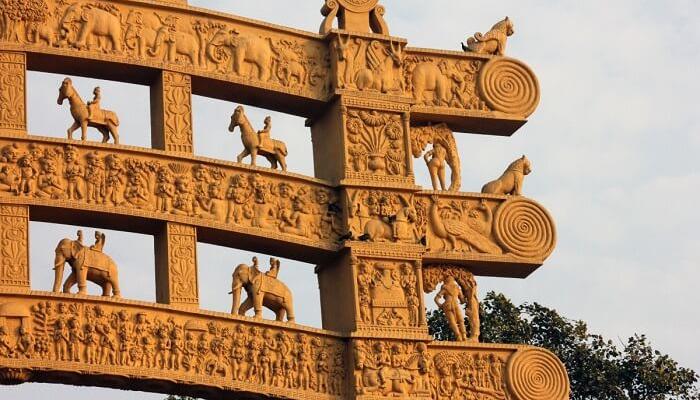
As it is perceived from the inscriptions, apparently the four complicatedly ornamented toranas or entry ways facing all the four directions and a decorated balustrade adjoining the stupa were added later in the first century BCE during the Satavahana rule. Various designs and motifs are carved on the railing and the gates of the Stupa.
The sculptures on the toranas consist of decorative illustrations of events encompassing the life of Lord Buddha as elucidated in the tales of Jataka. Inanimate figures like that of a tree are used here to symbolise Lord Buddha. One of the most striking features regarding the Stupa is that instead of images, Lord Buddha has been depicted symbolically by figures like thrones, wheels and footprints among others.
Things to do in Sanchi Stupa
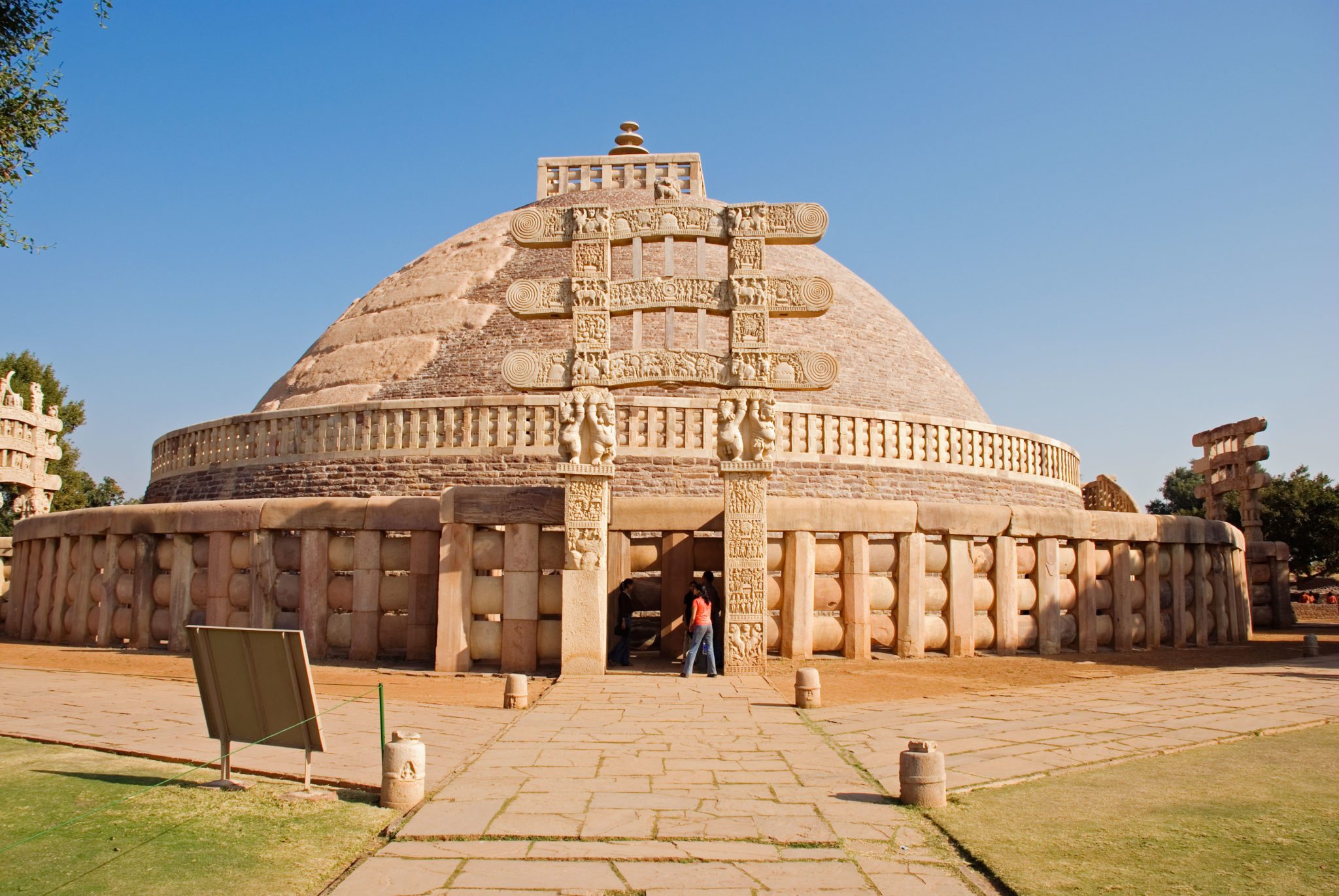
As a Buddhist Pilgrimage, there are a lot of things that you can see in this place. A few of the things that you can see in Sanchi are the following
1. The Iconic Toranas of the Great Stupa
Initial inscriptions specify that the tremendously decorative gateways on all the four directions plus the heavily imprinted balustrade marking the perimeter of the Stupa were supplemented to the original construction in the early 1st Century BC during the reign of the Satavahanas.
One taking a close look at the balustrades and the gateways you will notice a range of illustrations orbiting the life of the Buddha counting legends from Aryasura’s Jatakamala. It is exciting to note the way representative appearances of the Buddha shown through the carvings in the form of a tree or several other inanimate objects like thrones, wheels, or footprints.
2. Temple 40
The temple forty can be dated back to the early 3rd century BC. It is among the country’s first standing temples and it also has vestiges that date back to the various ages of Indian history. The earliest inscription was dated back to the Maurya dynasty which also specified that the building of the stupa was initiated by Ashoka’s father, Bindusara.
In its initial plan, the temple was built on a rectangular rock base that needed two flights of stair on its east and west side to reach the top. By the time of 2nd Century BC, the rectangular base was further extended and a pillared entrance was created of which currently only the stumps remain. There is also a little shrine lying in the corner of the rectangular platform. This was made in the 7th or 8th Century with the help of the already existing pillars.
3. Sanchi Museum
After you have descended from the hill where the Sanchi Stupa is located, you will see a single story building which is white in colour and is located in a compound of green gardens and tall trees. The name of this place is the ASI Museum and it was set up in the year 1919.
The director of its museum at this time was Sir John Hubert Marshal. The museum has four galleries which have numerous relics from the Buddhist Heritage of Sanchi and it also includes several artifacts from several of the kingdoms the entry fee of this place is INR 5. On Wednesdays, the Museum is shut for maintenance work in every week.
Some Interesting Facts about Sanchi Stupa
Sanchi, as the one of the few Buddhist pilgrim sites in India, has several interesting facts about them which people don’t know. A few of these fun and interesting facts about Sanchi are –
- The Sanchi Stupa is actually a dome shaped mound and also has a circumferential pathway which surrounds it.
- There are several chambers in the Stupa. In these chambers, there are several relics of the Lord Buddha.
- Not many people hold this information is that the initiation of building this Stupa was taken by the father of Great Indian Emperor Ashoka and it was built in the reign of Ashoka himself in the before Christ era.
- There was a time when the Sanchi Stupa was a repository bank. It was later that the Stupa and transformed into a monument which is purely symbolic.
- It is a fact that the Chunar Sandstone Pillar carries the renowned decree of Ashoka where he had warned the people against the faction in the community of Buddhism.
- The Sanchi Stupa has several carvings and relics of the Buddha in it. In these relics, the legendary Maurian Posh is still very much present.
- In the Sanchi Stupa, there is also a shrine which is dedicated to the Buddhist teachers who belonged to another Stupa outside the city of Sanchi.
- In the present Sanchi Stupa there is also an earlier version of the stupa which was made up by bricks and mud and it is kept encased.
- The Sanchi Stupa extends for a distance of 120 kilometres and that is excluding the umbrella and the railing.
- The height of the stupa is 54 feet, which is as long as 16.46 metres.
- In the years of 1912 to 1919, the Stupa had to undergo severe renovation and this was supervised by one Sir John Marshal.
- There are four gateways that surround the Stupa. These are the called the toranas. The toranas are carved in details and these were erected during the time of 35 BC.
- The Sanchi Stupa was a symbol that represented Buddha and it eventually had also become a symbol of the final release of Buddha from the cycle of birth and rebirth, or the final dying.
- The last time that construction work was done on the Sanchi Stupa, added to the stupa was four images of Lord Buddha in stone and those were placed against the wall and their faces were towards the gate.
- The four gateways of the Sanchi Stupa were made to depict a few scenes from the life of Buddha. These scenes were also taken from the Jatakas tales and stories are all related to the early birth and life of Buddha.
- Sanchi Stupa in Sanchi, Madhya Pradesh is a UNESCO World Heritage Site.
- The last addition to the Sanchi Stupa was done during the reign of the Guptas and it was before the year 450 AC.
- There are three parasols here that are located in the uppermost region of the Sanchi Stupa. These are set one above another and they are used to depict a heavenly hierarchy.
- In the middle of the 2nd century BC, Sanchi Stupa had undergone some severe damage.
- The Ashoka Pillar located here also has a crown. The crown is famous all throughout India because of the four lions here which stand back to back. It is also from this Ashoka Pillar in the Sanchi Stupa that the national emblem of India was first derived.
Tourist Attraction
Apart from the Sanchi Stupa, in the city of Sanchi, there are various other tourists spots that a lot of people would like to visit. Apart from the Sanchi Stupa in Sanchi, if you want to visit some other tourists spots in the city, a few choices that you might want to try are the Ashoka Pillar, the Great Bowl, the Udaygiri Caves, The Eastern Gateway, and last but not the least, the Sanchi Museum.
Best time to Visit Sanchi Stupa
Sanchi is the most appropriate Buddhist heritage and pilgrim destination in India. All throughout the year, the temperature of this place remains mildly high, but during the summers, they soar up. For the tourists, the best time to visit Sanchi Stupa would be to go during the months of October to March.
It is during this period, that the temperature is the most comfortable. It ranges from 15 to 30 degree Celsius during this time and is the most comfortable for sightseeing.
Fairs & Festival
There are not many fairs or festivals one can see in the city of Sanchi. However, one famous festival of Sanchi is the Chetiyagiri Vihara Festival. This festival is celebrated in Sanchi in the month of November. There are more than the normal number of tourists here who visit this place to see the relics of Sariputta and Mahamogallena, the two great disciples of Buddha.
Shopping
Sanchi is a religiously a very significant spot in Madhya Pradesh. The place is home to many Buddhist monuments, stupas, temples and doorways. Though this place is a not a typical shopping destination, there are a few things that you’d want yourself wanting to buy from Sanchi.
Some of the shops have souvenirs that the roadside vendors sell to the tourists. The competition among these vendors is high to find out who can sell more. After trying out some souvenirs from the roadside shops, there are also some shopping hubs that have a few more interesting products to buy.
The shops here also have a very good collection of handicrafts. A few examples of these are muslin woven by some top skilled craftsmen, zardozis, which are embroidered Indian Garments, leather works are also some of the greatest things that you can find in Sanchi.
How to Reach
Sanchi Stupa is only a short distance from Bhopal. Thus, it isn’t a problem for he visitors to just simply take a cab and visit the complex as this would have been the fastest and most convenient way to go there. The closest airport to this spot is the Raja Bhoj Airport and the nearest railway station is the Sanchi Railway Station. There is no metro station nearby. However, the bus stand closes to this complex is the Bhopal Bus Stand.

